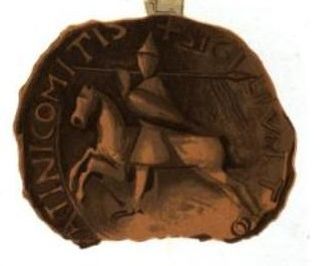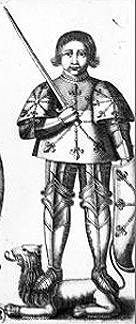
The Duchy of Brittany was a medieval feudal state that existed between approximately 939 and 1547. Its territory covered the northwestern peninsula of Europe, bordered by the Atlantic Ocean to the west, and the English Channel to the north. It was also less definitively bordered by the river Loire to the south, and Normandy, and other French provinces, to the east. The Duchy was established after the expulsion of Viking armies from the region around 939. The Duchy, in the 10th and 11th centuries, was politically unstable, with the dukes holding only limited power outside their own personal lands. The Duchy had mixed relationships with the neighbouring Duchy of Normandy, sometimes allying itself with Normandy, and at other times, such as the Breton–Norman War, entering into open conflict.

Theobald the Great (1090–1152) was count of Blois and of Chartres as Theobald IV from 1102 and was Count of Champagne and of Brie as Theobald II from 1125. Theobald held Auxerre, Maligny, Ervy, Troyes and Châteauvillain as fiefs from Odo II, Duke of Burgundy.

Alan III of Rennes was Count of Rennes and duke of Brittany, by right of succession from 1008 to his death.

Richard I, also known as Richard the Fearless, was the count of Rouen from 942 to 996. Dudo of Saint-Quentin, whom Richard commissioned to write the "De moribus et actis primorum Normanniae ducum", called him a dux. However, this use of the word may have been in the context of Richard's renowned leadership in war, and not as a reference to a title of nobility. Richard either introduced feudalism into Normandy or he greatly expanded it. By the end of his reign, the most important Norman landholders held their lands in feudal tenure.

Fulk III, the Black (c. 970–1040; Old French: Foulque Nerra was an early Count of Anjou celebrated as one of the first great builders of medieval castles. It is estimated Fulk constructed approximately 100 castles as well as abbeys throughout the Loire Valley in what is now France. He fought successive wars with neighbors in Brittany, Blois, Poitou and Aquitaine and made four pilgrimages to Jerusalem during the course of his life. He had two wives and three children.

Geoffrey II, called Martel, son of Fulk the Black, was Count of Anjou from 1040 to 1060 and Count of Vendôme from 1032 to 1056. He fought battles against William VII, Duke of Aquitaine, Theobald I, Count of Blois, and William, Duke of Normandy. During his twenty-year reign Geoffrey II faced the ambitions of the Bishop of Le Mans, Gervais de Château-du-Loir, but was able to maintain his authority over the County of Maine. Martel founded the Abbey aux Dames in Saintonge and also -in collaboration with his wife Agnes- founded the Abbaye de la Trinité at Vendôme. The first mention of Geoffrey II in the Gesta Normannorum Ducum reads: "Geoffrey, count of the Angevins, nicknamed Martel, a treacherous man in every respect, frequently inflicted assaults and intolerable pressure on his neighbors."
Rudolph III, called the Idle or the Pious, was the king of Burgundy from 993 until his death. He was the last ruler of an independent Kingdom of Burgundy, and the last male member of the Burgundian group of the Elder House of Welf.
Conan I, nicknamed Le Tort, was the Duke of Brittany from 990 to his death.

The House of Normandy designates the noble family which originates from the Duchy of Normandy and whose members were dukes of Normandy, counts of Rouen, as well as kings of England following the Norman conquest of England. It lasted until Stephen of the French House of Blois seized the English throne and the Duchy of Normandy in 1135. The house emerged from the union between the Viking Rollo and Poppa of Bayeux, a West Frankish noblewoman. William the Conqueror and his heirs down through 1135 were members of this dynasty while nearly every English monarch since William have been his descendant.

Odo II was the count of Blois, Chartres, Châteaudun, Champagne, Beauvais and Tours from 1004 and count of Troyes and Meaux from 1022. He twice tried to make himself a king: first in Italy after 1024 and then in Burgundy after 1032.

Odo I, Count of Blois, Chartres, Reims, Châteaudun and Omois, lord of Provins, was the son of Theobald I of Blois and Luitgard, daughter of Herbert II of Vermandois. He received the title of count palatine from King Lothair of West Francia.

The Counts of Dreux were a noble family of France, who took their title from the chief stronghold of their domain, the château of Dreux, which lies near the boundary between Normandy and the Île-de-France. They are notable for inheriting the Duchy of Brittany through Pierre de Dreux's marriage to Alix de Thouars in the early 13th century.

Gunnor or Gunnora was Duchess of Normandy by marriage to Richard I of Normandy, having previously been his long-time mistress. She functioned as regent of Normandy during the absence of her spouse, as well as the adviser to him and later to his successor, their son Richard II.
Herbert I, called Wakedog, was the count of Maine from 1017 until his death. He had a turbulent career with an early victory that may have contributed to his later decline.
Stephen of Penthièvre, Count of Tréguier, 3rd Lord of Richmond was a Breton noble and a younger son of Odo, Count of Penthièvre and Agnes of Cornouaille, sister of Hoël II, Duke of Brittany. In 1093, he succeeded to the title of Count of Tréguier; in 1098, he succeeded his brother Alain as Lord of Richmond in Yorkshire, England.
Odo was count of Troyes and of Meaux from 1047 to 1066, then count of Aumale from 1069 to 1115. He was later also known as the count of Champagne and as Eudes II of Troyes.

Hawise of Normandy was Countess of Rennes, Duchess of Brittany and Regent to her son Alan III, Duke of Brittany from 1008 until 1026.
William Crassus I , aka Le Gros or Gras and Grace, was the son of Stephen II Le Gros born 1112 second son of his parents were Stephen I(Etienne)and wife daughter of Roger De Mortimer. William was from an Anglo-Norman baronial family long established in central Normandy. The house of Blois He inherited Sodbury from his uncle, [[William le Gros, 1st Earl of Albemarle aka Guillaume le Gros, Count of Aumale; married Cecily de Rumily of Skipton,[a] daughter of William fitz Duncan.]], primo-genitus. Brother of Stephen II - William was granted a licence to hold fairs and markets in Chipping Sodbury in 1217.

Bertha of Blois, was a Duchess consort of Brittany and a countess consort of Maine.












